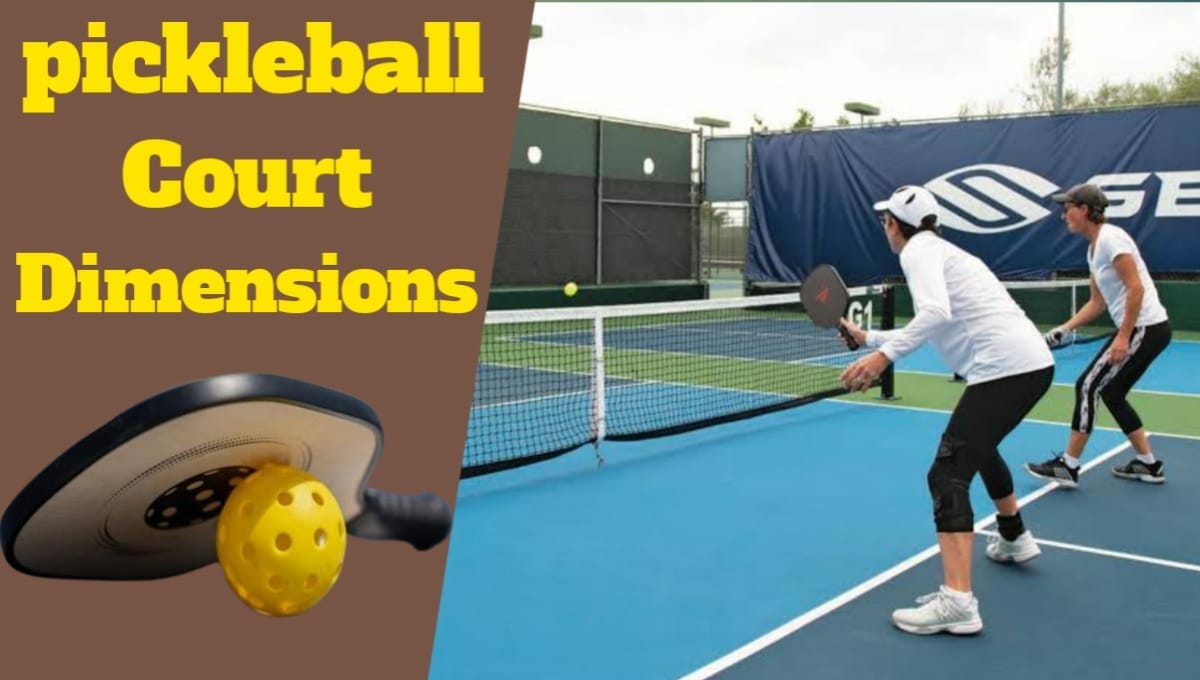Pickleball, the fastest-growing sport in the United States, must thoroughly understand its Pickleball Court Dimensions to master the game. In this comprehensive guide, we will delve into the exact measurements of a pickleball court and shed light on the significance of the kitchen area.
Whether you’re a novice player or a seasoned pro, this article will equip you with the knowledge to excel on the court.
Read Also:Top 10 Pickleball Mistakes I Have Ever Noticed in Beginners
Components of a Pickleball Court
To better understand the court dimensions, let’s explore the different components of a pickleball court.
The playing surface is typically made of asphalt or concrete and is rectangular. It comprises various boundary lines, including the baseline, sidelines, non-volley zone or kitchen, and service areas. The net, which divides the court into two halves, runs across the middle of the playing surface.
Unveiling the Pickleball Court Dimensions In Feet
To grasp the dynamics of pickleball fully, let’s begin by examining the precise dimensions of the court. Familiarizing yourself with these measurements will allow you to strategize effectively and optimize your gameplay.
Width
20 Feet The width of a pickleball court spans 20 feet. This measurement, extending horizontally across the court, determines the lateral range of movement for players during intense rallies.
Length
44 Feet The length of a pickleball court measures 44 feet. Running parallel to the net, this dimension provides ample space for players to engage in exhilarating back-and-forth exchanges.

Unmasking the Kitchen
An Essential Component While the Pickleball Court Dimensions lay the foundation for pickleball, it is crucial not to overlook the kitchen, a significant component that can greatly influence your gameplay. Understanding the kitchen’s placement and dimensions is vital for executing winning strategies.
The Kitchen Width
7 Feet The kitchen, known as the non-volley zone, spans 7 feet. Positioned immediately adjacent to the net, this area plays a pivotal role in dictating the game’s flow. It restricts players from executing volleys within its boundaries, enhancing the strategic aspect of the sport.
Distance from the Net
7 Feet From the kitchen line to the net, a distance of 7 feet is maintained. This space is a buffer zone, preventing players from lunging forward and volleying directly at the net. It encourages more strategic shots and promotes fair gameplay.
The Importance of Proper Pickleball Court Dimensions
Proper pickleball court dimensions are crucial for several reasons. Firstly, they ensure fairness and consistency in gameplay, allowing players to execute shots and strategies effectively. Secondly, adhering to standard court dimensions enables players to participate confidently in tournaments and competitive events.
Lastly, well-maintained courts with accurate dimensions contribute to the overall aesthetics and safety of the game.
Tips for Building a Pickleball Court
If you’re considering building a pickleball court, here are some essential tips to keep in mind:
- Choose an appropriate location with sufficient space for a full-size court.
- Prepare the foundation properly to ensure durability and stability.
- Use high-quality materials for the playing surface to enhance gameplay.
- Install clear and visible boundary lines for accurate gameplay.
/
Maintaining and Marking the Court
Maintaining and marking the pickleball court ensures its longevity and proper gameplay. Here are some important considerations:
- Regularly clean the court surface to remove debris, dirt, and leaves that may affect gameplay.
- Inspect and repair any cracks or damages on the court to maintain its integrity.
- Use high-quality court paints and tapes to mark the boundary lines accurately.
- Reapply the paint or tape periodically to prevent fading or peeling.
Faqs
Q: Can I use a smaller court for recreational play?
A: While official pickleball court dimensions are recommended for a standardized experience, recreational play can be adapted to smaller spaces as long as the basic elements of the game are maintained.
Q: Are there specific dimensions for the non-volley zone or kitchen?
A: The non-volley zone extends 7 feet from the net on both sides and should be marked. It helps prevent players from volleying the ball near the net, promoting fair play and strategic shots.
Q: Can I modify the court dimensions for personal use?
A: Absolutely! You can adapt the court dimensions to suit your needs if you have specific space constraints or preferences. However, it’s important to remember that official dimensions may be required for competitive play.
Q: How should I measure and mark the court accurately?
A: Measuring tapes and court stencils are recommended to ensure precise measurements and markings. Taking your time during this process will contribute to the overall quality of the court.
Q: What is the recommended surface for a pickleball court?
A: Asphalt and concrete surfaces are commonly used for pickleball courts due to their durability and ability to provide consistent ball bounce. However, alternative surfaces such as synthetic turf or wood may also be suitable, depending on personal preference.
Conclusion
By familiarizing yourself with the Pickleball Court Dimensions and recognizing the significance of the kitchen area, you are poised to elevate your performance and dominate the game. Remember, the 20 feet width and 44 feet length provide ample space for intense rallies, while the 7 feet-wide kitchen area adds a tactical element to your gameplay.
Embrace these dimensions, refine your strategies, and unleash your true potential on the pickleball court. Get ready to experience the thrill and excitement of this incredible sport like never before!
